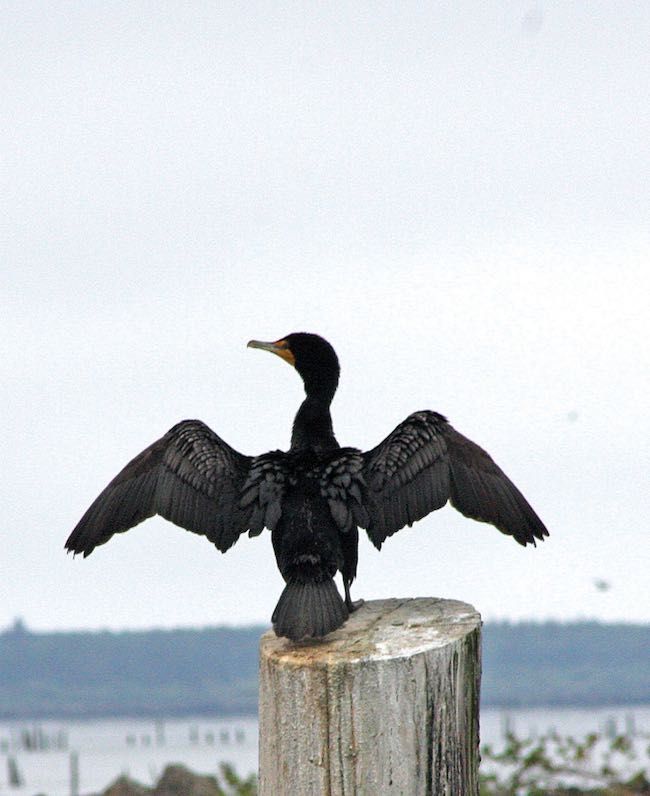forum
library
tutorial
contact

Killing Cormorants
by Gosia WozniackaChinook Observer, August 13, 2019
|
the film forum library tutorial contact |

|
Killing Cormorantsby Gosia WozniackaChinook Observer, August 13, 2019 |
 PORTLAND -- Conservation groups opposed to the ongoing killing of cormorants on the Columbia River to protect steelhead and salmon say they have documents showing a federal agency ignored a finding by its own biologists that the measure would not help the fish.
PORTLAND -- Conservation groups opposed to the ongoing killing of cormorants on the Columbia River to protect steelhead and salmon say they have documents showing a federal agency ignored a finding by its own biologists that the measure would not help the fish.
The Audubon Society of Portland and several other groups made the documents public on Aug. 12. They were obtained from the U.S. Fish and Wildlife Service under a court order.
The groups had challenged the killing in a federal lawsuit. In May, a judge declined to block the plan to shoot the cormorants, but the lawsuit is ongoing.
One of the newly disclosed documents is an analysis by U.S. Fish and Wildlife biologists concluding that killing double-crested cormorants would not benefit Snake River steelhead -- which are most affected by cormorant predation -- because fish not eaten by the birds would be eaten by other predators.
"As a consequence, efforts to reduce cormorant predation on steelhead are expected to have no effect on Snake River steelhead population productivity or adult abundance," the analysis says. It adds that killing cormorants is "similarly unlikely to benefit the productivity of... other salmonid populations."
The second document, a timeline written by Fish and Wildlife biologists, shows multiple staff at the agency were aware of the analysis and its conclusion. It also shows the biologists were concerned that the U.S. Corps of Engineers did not address their findings.
Despite the analysis, earlier this year U.S. Fish and Wildlife authorized the Corps to kill about 11,000 cormorants -- or 5,600 breeding pairs -- on East Sand Island at the mouth of the Columbia between Oregon and Washington. The uninhabited island near Chinook is North America's biggest cormorant nesting colony. The agency also authorized the Corps to oil 26,000 nests to prevent the eggs inside them from hatching.
Both agencies declined to comment on the documents, citing ongoing litigation. It's unclear whether the Corps was aware of the analysis when it wrote its environmental impact statement.
Federal agencies blame the cormorants for eating an average 12 million juvenile salmon a year as they migrate down the Columbia to the ocean. Some of the fish are federally protected species.
Bob Sallinger, conservation director for the Audubon Society of Portland, said conservation groups repeatedly asked the agencies whether killing cormorants would make a difference.
"We went through a major public process, which is supposed to ensure transparency," said Sallinger. "They never disclosed that their own biologists were fundamentally questioning the efficacy of this action. They chose to bury it and that's unconscionable."
Sallinger also said the analysis confirmed what conservation groups have been saying all along, including in their lawsuit: that it's the dams that most impact fish. In their analysis, the federal biologists found that efforts to reduce mortality during passage through the hydro system on the Columbia would result in increased productivity and abundance of steelhead.
The focus on cormorants, Sallinger said, is "about distracting the public from the real reason of salmon decline, the hydro system. They're spending tax dollars killing protected birds that will have absolutely no impact on salmon."
The conservationists are calling for the government to stop killing the cormorants, and to launch an investigation into why the agencies ignored their own biologists' findings and didn't disclose the documents to the public. So far, 158 cormorants have been killed using .22-caliber rifles and more than 5,089 nests have been oiled, destroying the eggs inside them.
Cormorants are not the only animals to be targeted for eating salmon. Caspian terns have also been pushed off an island in the Columbia, and sea lions have been killed to reduce the numbers of salmon eaten.
Related Pages:
Breach Snake Dams; Leave Birds Alone by Joe Paliani, Chinook Observer, 8/15/19
learn more on topics covered in the film
see the video
read the script
learn the songs
discussion forum
